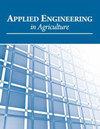Development of the Manure Distributing Machine
IF 0.8
4区 农林科学
Q4 AGRICULTURAL ENGINEERING
引用次数: 0
Abstract
HighlightsIn this study, a compact, mobile manure distributor capable of operating effectively on narrow farm roads and applying undiluted, highly concentrated manure on fields was developed.The inclusion of three manure distribution functions is expected to reduce manure transport and application costs.The use of this machine can reduce livestock waste disposal costs, increase soil fertility, enhance the physical and chemical properties of soil, reduce the use of commercial fertilizers when planting crops, upgrade the technology employed for recycling domestic livestock resources, and assist with animal husbandry by facilitating the planting of forage and high-energy crops.Abstract. In this study, the aim has been developed a manure collecting, processing, and distributing processor (machine) that is suitable for farming in Taiwan’s agricultural lands. The designed machine is composed of a stirring and draw unit, a manure containing barrel, a manure output mechanism, a ditch excavator, and a soil covering device or filling pipes set with pan-breakers. A tractor both carries and supplies power to the machine. Undiluted manure is pumped from an anaerobic fermentation tank into the manure containing barrel within which the stirring and draw unit is set, and after the manure is thoroughly mixed and stirred, it well the manure is delivered to the manure output mechanism through a 2-in. round pipe. The processing and spreading units developed here are soil-surface-spreading type, soil-stratum-setting type, and deep-soil-setting type. The soil-surface spreading type unit output manure on land surface directly then mixes the manure into soil by tillage, the soil-stratum-setting-type unit uses the ditch excavator to first dig a ditch, and after manure is pumped into the ditch, the soil covering device covers the ditch with the excavated soil. The deep soil setting enables manure to be deposited 30~40 cm below the soil surface, with the loose soil being spread back over the manure after filling. In field tests, manure was spread over the soil surface, incorporated into the soil, or deep filled into subsoil at three test sites, namely Yilan County riverside land, the Tainan County Livestock Research Institute, and a sweet potato field and cornfield in Tainan County. The results revealed that the 3-ton capacity of soil-stratum-setting method field capacity reached 0.58 ha/h at a speed of 2.92 ± 0.07 km/h, and the average cultivation depth was 17.5 ± 0.3 cm. The 5-ton capacity of soil-surface-spreading method working capacity was 1.02 ha/h at a speed of 3.49 ± 0.23 km/h. The 5-ton capacity of soil-stratum-setting method working capacity was 0.61 ha/h at a speed of 2.52 ± 0.32 km/h, and the average cultivation depth was 21.29 ± 1.31 cm. For the 5-ton capacity barrel of the deep-soil-setting type manure spreading machine field capacity was 0.62 ha/h at a speed of 2.8 ± 0.43 km/h. By using the soil-surface-spreading method can fast to handle livestock wastewater and/or manure spray-on land, and using the soil-stratum-setting method or deep-soil-setting method can reduce odor dissipation and fill it directly. Thus, this study successfully developed the compact, mobile, and domestically made manure-distributing processor that can suitably operate in Taiwan farm roads and apply undiluted, highly concentrated manure on fields. The three manure-distributing methods are expected to lower manure transport and application costs. Keywords: Fertilizer spreading, Reuse, Swine manure, Waste reduction.散肥机的研制
在本研究中,开发了一种紧凑的移动粪肥分配器,能够在狭窄的农场道路上有效地运行,并在田间施用未稀释的高浓度粪肥。纳入三种粪肥分配函数有望降低粪肥运输和施用成本。使用该设备可以降低畜禽废弃物处理成本,提高土壤肥力,增强土壤理化性质,减少作物种植时商品肥料的使用,提高家畜资源循环利用技术,方便牧草和高能作物的种植,辅助畜牧业发展。本研究的目的是开发一种适合台湾农地耕作的粪便收集、加工及分配机(机)。所设计的机器由搅拌抽吸装置、装粪桶、排粪机构、挖沟机、覆土装置或设置有破锅器的充填管道组成。拖拉机既为机器输送动力又为机器提供动力。将未稀释的粪便从厌氧发酵罐中泵入设置有搅拌抽放装置的装粪桶中,将粪便充分混合搅拌后,通过2英寸的排粪器送入排粪机构。圆管。这里发育的加工铺展单元有土壤-地表铺展型、土壤-地层铺展型和深层铺展型。土面铺展式机组直接在地表输出粪肥,然后通过耕作将粪肥混合到土壤中,土层铺展式机组利用挖沟机先挖沟,将粪肥泵入沟中后,用挖出的土壤覆盖装置覆盖在沟里。深厚的土壤设置使粪肥在土壤表面下30~40厘米处沉积,填埋后松散的土壤覆盖在粪肥上。在田间试验中,在宜兰县河滨地、台南县畜牧研究所、台南县甘薯田和玉米地三个试验点,将粪便铺在土壤表面、混入土壤或深填到底土中。结果表明:3吨土壤层筑法田间容量为0.58 ha/h,种植速度为2.92±0.07 km/h,平均种植深度为17.5±0.3 cm;5吨土壤-地表扩散法工作能力为1.02 ha/h,速度为3.49±0.23 km/h。5吨土壤分层法工作容量为0.61 ha/h,速度为2.52±0.32 km/h,平均种植深度为21.29±1.31 cm。深埋式施肥机5吨容量桶,施肥速度为2.8±0.43 km/h,施肥量为0.62 ha/h。采用土壤表面铺布法可以快速处理牲畜废水和/或粪便喷洒在土地上,采用土壤层垫法或深层土垫法可以减少气味的消散和直接填充。因此,本研究成功开发出一种小型、可移动、国产的粪肥分配处理机,适用于台湾农场道路,并可在田间施用未稀释的高浓度粪肥。这三种粪便分配方法有望降低粪便运输和施用成本。关键词:施肥,再利用,猪粪,减量化
本文章由计算机程序翻译,如有差异,请以英文原文为准。
求助全文
约1分钟内获得全文
求助全文
来源期刊

Applied Engineering in Agriculture
农林科学-农业工程
CiteScore
1.80
自引率
11.10%
发文量
69
审稿时长
6 months
期刊介绍:
This peer-reviewed journal publishes applications of engineering and technology research that address agricultural, food, and biological systems problems. Submissions must include results of practical experiences, tests, or trials presented in a manner and style that will allow easy adaptation by others; results of reviews or studies of installations or applications with substantially new or significant information not readily available in other refereed publications; or a description of successful methods of techniques of education, outreach, or technology transfer.
 求助内容:
求助内容: 应助结果提醒方式:
应助结果提醒方式:


